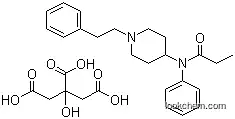Products Categories
| CAS No.: | 437-38-7 |
|---|---|
| Name: | FENTANYL |
| Article Data: | 26 |
| Molecular Structure: | |
|
|
|
| Formula: | C22H28N2O |
| Molecular Weight: | 336.477 |
| Synonyms: | Propionanilide,N-(1-phenethyl-4-piperidyl)- (7CI,8CI);1-Phenethyl-4-(N-phenylpropionamido)piperidine;1-Phenethyl-4-N-propionylanilinopiperidine;Durogesic D-Trans;Durotep MT;Fentanest;Fentanil;Fentanyl;Fentora;Matrifen;N-(1-Phenethylpiperidin-4-yl)-N-phenylpropionamide;N-[1-(2-Phenylethyl)-4-piperidinyl]propionanilide; |
| EINECS: | 207-113-6 |
| Density: | 1.087 g/cm3 |
| Melting Point: | 83-84 °C |
| Boiling Point: | 466.2 °C at 760 mmHg |
| Flash Point: | 185.8 °C |
| Solubility: | 0.2g/L(25 oC) |
| Appearance: | Pale brown solid |
| Hazard Symbols: | F,T |
| Risk Codes: | 11-23/25-36/38-39/23/24/25-23/24/25 |
| Safety: | 16-24-45-36/37-7 |
| PSA: | 23.55000 |
| LogP: | 4.07460 |
- 483366-12-7(2S,4R)-1-Boc-2-cyano-4-hydroxypyrrolidine
- 5156-58-1N-(1-Benzyl-4-pipperidinyl)-N-phenylpropanamide HCl
- 81281-59-67-Benzylideneaminotheophylline
- 50288-62-5threo-Phenyl-2-piperidyl acetamide
- 82993-81-5D-threo-Ritalinic acid hydrochloride
- 47087-37-6Z-D-Glu-OMe
- 73441-42-6METHYL-5-CHLORO-2,2-DIMETHYLVALERATE
- 68439-39-4Poly(oxy-1,2-ethanediyl), alpha-(2-ethylhexyl)-omega-hydroxy-,
- 852475-26-4MC1568
- 958254-66-51H-Imidazo[4,5-b]pyridine-2-carboxaldehyde, 1-methyl-, hydrochloride
 This product is a nationally controlled contraband, and the Lookchem platform doesn't provide relevant sales information.
This product is a nationally controlled contraband, and the Lookchem platform doesn't provide relevant sales information.
History
Fentanyl (437-38-7) was first synthesized by Paul Janssen under the label of his relatively newly formed Janssen Pharmaceutica in 1959. In the 1960s, fentanyl was introduced as an intravenous anesthetic under the trade name of Sublimaze. In the mid-1990s, Janssen Pharmaceutica developed and introduced into clinical trials the Duragesic patch..
Following the patch, a flavored lollipop of fentanyl citrate mixed with inert fillers was introduced under the brand name of Actiq, becoming the first quick-acting formation of fentanyl for use with chronic breakthrough pain. More recently, fentanyl has been developed into an effervescent tab for buccal absorption much like the Actiq lollipop, followed by a buccal spray device for fast-acting relief and other delivery methods currently in development.
A new Fentanyl product has just been approved by the FDA for breakthrough cancer pain called Onsolis. There appears to be less abuse potential because the drug can not be crushed up and snorted like other Fentanyl product. It also has less of a chance of causing mouth ulcers for patients needing to use Fentanyl for breakthrough cancer pain.
Specification
The Phentanyl with CAS registry number of 437-38-7 is also known as Propanamide,N-phenyl-N-[1-(2-phenylethyl)-4-piperidinyl]-. The IUPAC name is N-Phenyl-N-[1-(2-phenylethyl)piperidin-4-yl]propanamide. It belongs to product categories of Intermediates & Fine Chemicals; Pharmaceuticals. Its EINECS registry number is 207-113-6. In addition, the formula is C22H28N2O and the molecular weight is 336.47. What's more, it can be used as an analgesic and controlled substance.
Physical properties about Phentanyl are: (1)ACD/LogP: 3.89; (2)# of Rule of 5 Violations: 0; (3)ACD/LogD (pH 5.5): 1.02; (4)ACD/LogD (pH 7.4): 2.53; (5)ACD/BCF (pH 5.5): 1; (6)ACD/BCF (pH 7.4): 23.4; (7)ACD/KOC (pH 5.5): 4.24; (8)ACD/KOC (pH 7.4): 136.78; (9)#H bond acceptors: 3; (10)#H bond donors: 0; (11)#Freely Rotating Bonds: 6; (12)Index of Refraction: 1.584; (13)Molar Refractivity: 103.66 cm3; (14)Molar Volume: 309.3 cm3; (15)Surface Tension: 45.7 dyne/cm; (16)Density: 1.087 g/cm3; (17)Flash Point: 185.8 °C; (18)Enthalpy of Vaporization: 72.79 kJ/mol; (19)Boiling Point: 466.2 °C at 760 mmHg; (20)Vapour Pressure: 7.25E-09 mmHg at 25 °C.
Uses of Phentanyl: it is used to produce N-[1-(2-phenylethyl)-4-piperidinyl]thiopropionanilide. The reaction occurs with reagents P4S10, pyridine, water with other condition of heating for 2 hours. The yield is about 35%.
![Phentanyl is used to produce N-[1-(2-phenylethyl)-4-piperidinyl]thiopropionanilide.](/UserFilesUpload/Uses of Phentanyl.png)
You can still convert the following datas into molecular structure:
1. Canonical SMILES: CCC(=O)N(C1CCN(CC1)CCC2=CC=CC=C2)C3=CC=CC=C3
2. InChI: InChI=1S/C22H28N2O/c1-2-22(25)24(20-11-7-4-8-12-20)21-14-17-23(18-15-21)16-13-19-9-5-3-6-10-19/h3-12,21H,2,13-18H2,1H3
3. InChIKey: PJMPHNIQZUBGLI-UHFFFAOYSA-N
The toxicity data is as follows:
| Organism | Test Type | Route | Reported Dose (Normalized Dose) | Effect | Source |
|---|---|---|---|---|---|
| human | TDLo | intravenous | 2ug/kg (0.002mg/kg) | BEHAVIORAL: SOMNOLENCE (GENERAL DEPRESSED ACTIVITY) LUNGS, THORAX, OR RESPIRATION: RESPIRATORY DEPRESSION | British Medical Journal. Vol. 1, Pg. 278, 1978. |
| mouse | LD50 | intraperitoneal | 76mg/kg (76mg/kg) | BEHAVIORAL: EUPHORIA | Pharmaceutical Chemistry Journal Vol. 10, Pg. 1193, 1976. |
| mouse | LD50 | intravenous | 2900ug/kg (2.9mg/kg) | Toksikologicheskii Vestnik. Vol. (4), Pg. 20, 1995. | |
| mouse | LD50 | oral | 368mg/kg (368mg/kg) | Toksikologicheskii Vestnik. Vol. (4), Pg. 20, 1995. | |
| mouse | LD50 | subcutaneous | 62mg/kg (62mg/kg) | Toksikologicheskii Vestnik. Vol. (4), Pg. 20, 1995. | |
| rat | LD | intraspinal | > 10mg/kg (10mg/kg) | Acta Pharmacologica et Toxicologica. Vol. 56, Pg. 50, 1985. | |
| rat | LD50 | intravenous | 2910ug/kg (2.91mg/kg) | Journal of Medicinal Chemistry. Vol. 17, Pg. 1047, 1974. | |
| rat | LD50 | oral | 18mg/kg (18mg/kg) | Journal of Pharmacy and Pharmacology. Vol. 25, Pg. 929, 1973. | |
| rat | LD50 | subcutaneous | 1500ug/kg (1.5mg/kg) | Pharmaceutical Chemistry Journal Vol. 23, Pg. 395, 1989. | |
| women | TDLo | oral | 100ug/kg (0.1mg/kg) | LUNGS, THORAX, OR RESPIRATION: CYANOSIS LUNGS, THORAX, OR RESPIRATION: OTHER CHANGES | Annals of Emergency Medicine. Vol. 35, Pg. 314, 2000. |
